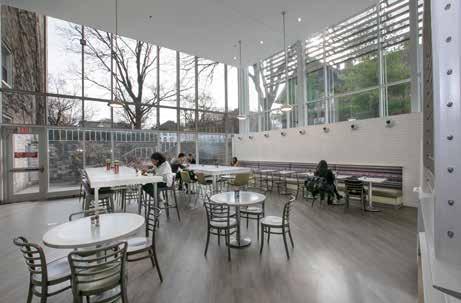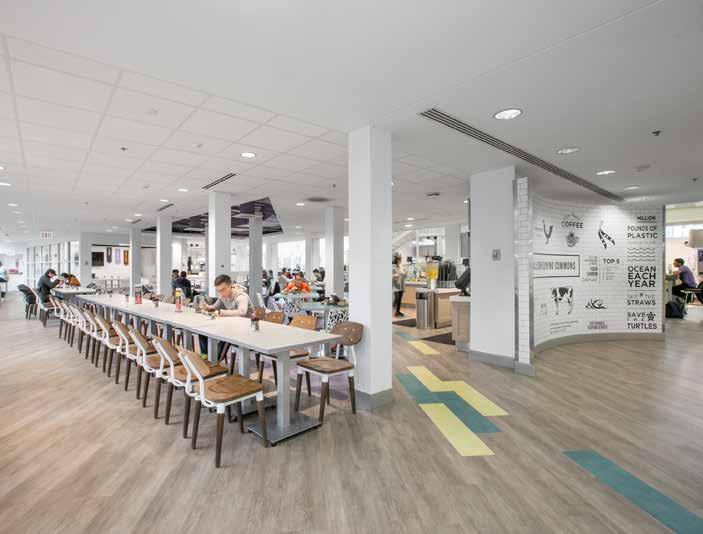
9 minute read
Meet me at the hub
from CCR Issue 7
Christopher Collins, AIA, NCARB, Principal of Architecture, Nvironment
A special supplement to:
Liz Hauswald, Principal of Design, Nvironment
Meet me at the hub
Time has an amazing way of changing things. In 1960, Allison Hall opened on the Northwestern University campus as residence for firstyear women. In the ensuing 60-plus years, Allison Hub has become a hub for south area Northwestern students.

And thanks to its in-building dining commons, nobody ever goes hungry. We’re not talking just your regular college fare; we’re talking comprehensive meal choices like vegan, halal, Kosher, vegetarian, and more. As part of the $19M investment by the universities food service partner Compass Group, there were upgrades throughout the Evanston and Chicago campuses, highlighted by dramatic improvements to the Elder and Allison Hall dining commons. We sat down with Liz Hauswald, Principal of Design; and Christopher Collins, AIA, NCARB, Principal of Architecture at Nvironment, to get an inside look at what puts Allison Hall on the cutting edge of university food service offerings.




Give us a snapshot of the restaurant brand.
Northwestern University’s Allison Dining Hall contains seven different food platforms, plus a dedicated Kosher kitchen. The array of open-view food prep spaces, plus redefined seating, made this dining build-out an experience like no other.
What was the inspiration behind that concept?
Deciding how to make the most of an existing space, working within existing physical parameters and creating a fresh food hall experience inspired this rebuild from all new angles. It may sound too simplistic to say the floor inspired us, but raising a sizable portion of the seating with a mezzanine provided a solution to house new theatre style cooking without sacrificing seating count.
What type of consumer are you targeting?
The Allison Dining venue was designed expressly for students of the University, since food options are one of the top decision making criteria for student enrollment. University faculty and staff as well as any other visitors also are encouraged to dine at the Allison, since it is, after all, state of the art.
What are some of the adjustments you made with/to your business model surrounding the recent state of events?
The biggest adjustment for Allison Dining was being shut down for the past year and a half. But in reopening, the venue has been following CDC and University guidelines. However, the flexible seating we installed (as opposed to the limited seating from before) does allow for better options when it comes to social distancing.
What kind of conversations are you having with your customers?
Customers are far more sophisticated these days, and appreciative of freshness cues along with a better overall experience. This allows space for creativity in design to come about. Namely, we were able to blow open
the back of the house, completely exposing it, as well as moving seating right up to the kitchen, which brings a more immersive experience overall. How’s that for food preparation transparency?
How does the design of the restaurant cater to what today’s consumers are looking for?
Adding the kind of transparency customers are looking for allowed us to get creative with the space. By exposing the kitchen, we unlocked a new style of queueing. Now, people congregate around their choice of fare and chat with the kitchen staff who’s preparing their meals.

Is there a location that really shows how the brand interacts with the community and customers? One of your favorites?
The pizza station is one of the most iconic places in this dining hall. Sidled up against a multi-purpose dining/teaching kitchen/meeting space, this area can be opened-up after hours for a completely unique culinary event. During the day, the blazing oven churns out made to order pie after pie in front of the customers who gather at the dining counter to chat with the chef.
Walk us through how and why it’s designed the way it is.
Typically, aging university dining halls were configured with segregated servery and dining spaces with an outdated “tray load” approach. Allison was no exception, and working within existing parameters like structural elements and fenestration limitations means, unlike the axiom, function has to follow form. Whenever we approach an adaptive reuse situation, we take what is given and rework a new spin on it. It’s one of our specialties, actually.



Take us through your construction and design strategy.
Looking at the existing challenges, we noticed the existing atrium had very limited seating options and wasn’t living up to its potential. Two solid ideas formed: Installing a mezzanine to nearly double seating options, and exposing the kitchen area with integrated seating to give customers plenty of opportunities to mingle. From there, it was a matter of making it look great.
Give us a rundown of the market’s layout.
University students today are far more sophisticated than years past. Fresh food and made to order options are expected and rotating menus for a diverse palate are a must. By gathering seven different options, plus Kosher, and adding two fresh microgreens grow cabinets, we were sure to exceed everyone’s expectations.
Talk about sustainability. What are you doing?
We mentioned the microgreens grow cabinets, but what’s more sustainable about those is how they helped boost local growers. Once the students discovered the microgreens, and interest increased, the operations staff collaborated with local producers to meet the demand and create a win/win proposition to support local businesses. Along with that slam-dunk, we also utilized energy-efficient food-service equipment, LED lighting and natural daylighting, and the multi-stream recycling program we put in most of our designs.

What’s the biggest issue today related to the construction side of the business?
There are always problems that pop up during any construction project, but the most frustrating—and often most debilitating to the initial design—issue currently is material and equipment availability or lead times. Everything, from fabrics, flooring, cladding and cooking equipment, seems to be in conflict with aggressive development schedules. This can be especially problematic when it comes to limited time tables such as those corresponding to the academic calendar.
Are you optimistic about how the marketplace has responded to everything happening today?
If ever there was a way to move past the events of recent years, it has to be by gathering around food. Food brings consistency and camaraderie in a way that nothing else can. This means working on dining projects comes with an innate optimism—even in the midst of a global pandemic. As Luciano Pavarotti said, “One of the very nicest things about life is that we must regularly stop whatever it is we are doing and devote our attention to eating.”
What’s your growth plan? What areas are you targeting?
As Nvironment, being able to apply what we’ve learned over the years completing retail, restaurant and food-service projects, we’d like to gain additional exposure to hospitality projects. We think it would be really fun to provide the same value in customer experience we executed for Northwestern, and dozens of other brands, to a new client base.
What trends are you seeing?
Student diners today are looking for: greater transparency with food prep; alternative and flexible seating arrangements; charging stations, speed in relation to dine-out, mobile and kiosk ordering, grabn-go options, and fresh/local ingredients; choices to satisfy a highly refined palate. I mean, when exactly did sushi become an expected part of college fare?
What’s the secret to creating a “must visit” restaurant environment in today’s competitive landscape?
Beyond all the trimmings and trappings that might be slapped on your dining room, a good culinary experience wins every time. In short: You want a broader and authentic flavor profile in an Instagram-able environment.
What is today’s consumer looking for?
Mostly, and perhaps more-so due to pandemic events, customers want a curated experience; a space that feels comfortable and friendly while still being remarkably utilitarian, that serves a wide arrange of flavors, offers flexible seating experiences and takes advantage of modern technology with ordering options. CK
One-on-One with
What’s the biggest item on your to-do list right now? At Nvironment, we are redoubling our efforts to bring the best communication we can to the table. Our collaboration has been a hallmark of our company, and a yearplus of virtual calls has made us a bit antsy. Getting back to “business as usual” is priority number one.
Describe a typical day. When you love what you do, the days aren’t really quantifiable. It starts with coffee, to be sure. Then we have conversations with employees, clients and vendors, and somewhere in all that, we crank out great work.
What’s the best thing a client ever said to you? It’s not any specific thing, but when you get the call saying, “The space looks great, it’s holding up well, we’re making profit and customer’s love it,” that’s all the thanks we need. And when a client says, “It looks just like the rendering,” that doesn’t hurt either. Tell us what makes your brand so unique? Our collaboration is a cornerstone to our business. In the case of Allison, collaboration allowed us to key-in on the customer’s needs while pulling out a really clever use of an existing space.
What’s the most rewarding part of your job? We love seeing our spaces come to life—and to turn out how as envisioned. This may sound selfish, but in reality, it means we did everything our customers asked of us. And that’s always a good feeling.
What was the best advice you ever received? “You can be wrong, but don’t be wrong long,” as bad news doesn’t get better with age, so tackle obstacles head on. Good for business and for life.
Name the three strongest traits any leader should have and why. Patience, Communication and Empathy. Because without these three traits, collaboration can never happen.










